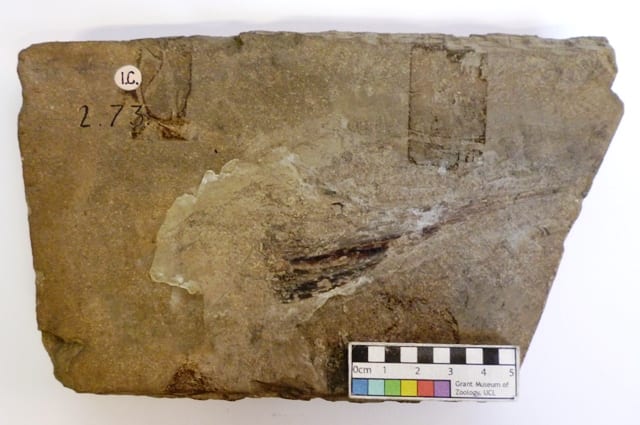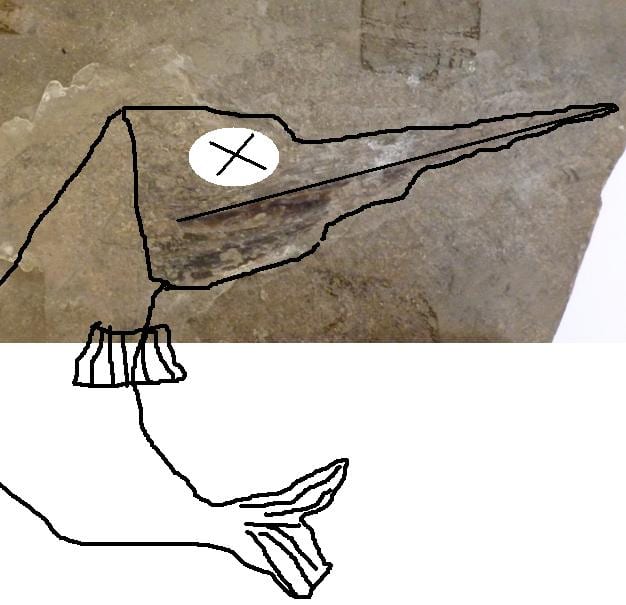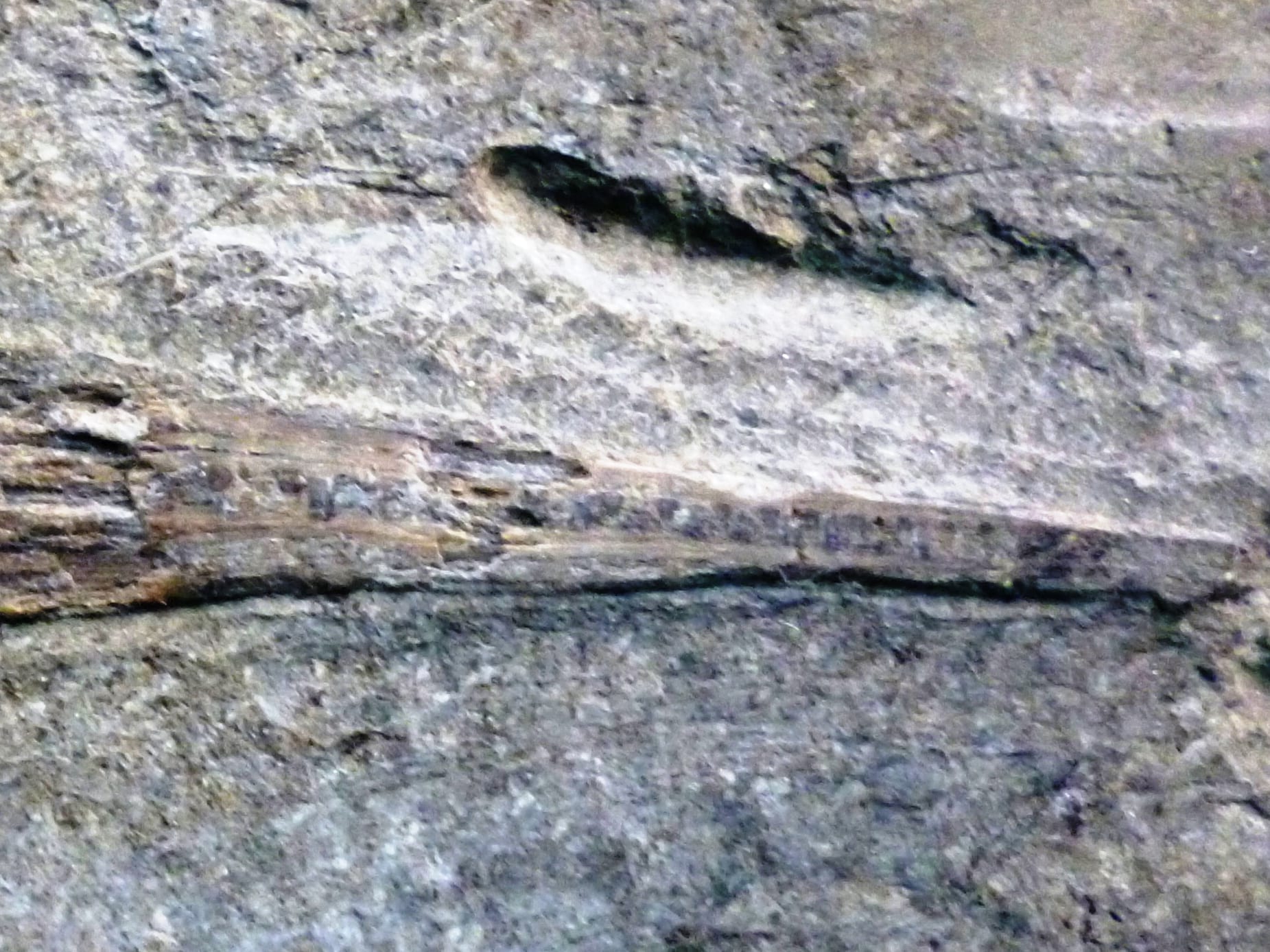Underwhelming Fossil Fish of the Month: July 2014
By Mark Carnall, on 25 July 2014
I’ll be honest with you reader, I’m totally phoning in this month’s underwhelming fossil fish of the month. When I pulled last month’s underwhelming fossil fish out of the drawer it looked to me like a small but slender mandible which I lazily attributed to the fish Saurichthys. I then wrote what I can only describe as the greatest underwhelming fossil fish of the month blog post in the world. Confidently, I scheduled it to be published and then actually looked at the specimen and re identified it as the now infamous caudal fulcrum of Chondrosteus. In a fit of shame, the dark side of science we don’t often talk about, I printed out the blog post, then shredded it and then burnt the shreds. I sent the ashes to the four corners of Earth and then deleted the original blog and rewrote one for Chondrosteus. So this month I am writing about Saurichthys but, as is always the case, the rewrite was nowhere near as interesting, engaging or downright life changing as the original lost version. Suffice to say, this is not the greatest underwhelming fossil fish of the month blog post in the world. This is just a tribute.
Here’s this month’s underwhelming fossil fish of the month, I’ll leave it to your eyeholes to take in for a bit. Look out for the bonus sellotape adhesive marks!

Something to tell the grandchildren about. LDUCZ-V1523 Acidorhynchus acutus from the Grant Museum of Zoology UCL. BONUS TAPE MARKS!
This month’s specimen is going to end up whelming some of you I’m afraid. What we have here is most of the head of the fish, Acidorhynchus acutus. Acidorhynchus acutus is an extinct ray-finnned fish found in Triassic Jurassic sediments across Europe and Canada. They were highly streamlined fish with a very long snout, accounting for up to a third of the total body length. They are thought to have been very speedy predators in the ancient seas. The specimen we have here is a rather nicely preserved head, the interpretation, as ever, aided by this expert artist’s reconstruction.

A very poorly realised reconstruction of fossil fish specimen LDUCZ-V1523 Acidorhynchus acutus. 4/10 Try Harder!
Acidorhynchus is a genus in the family Saurichthyidae, the lizard fish (not to be confused with the extinct marine reptiles Ichthyosauridae, the fish lizards) from the Greek ichthys meaning “fish” and sauros meaning “lizard”. There’s some confusion over the exact classification of the genera in this group with this particular species being placed in three different genera in the family over the years, two of which are still inconsistently used.
Preservation This is a rather nicely preserved specimen albeit it rather faint with many specimens found in the Holzmaden/Posidonia Shale Lagerstätte (site of exceptional preservation) in Germany. The information with this specimen doesn’t detail the collection locality. This specimen seems to have been preserved in a fine grained shale and although the post cranial skeleton and top of the skull aren’t present here, there is a high level of detail preserved in jaws and even the small triangular teeth can be seen under the ever disappointing but cheap USB microscope.

Disappointing but cheap USB microscope imaged rostrum of LDUCZ-V1523 Acidorhynchus acutus. The slightly darker pixels between the brown pixels are teeth. Clearly.
Research Given that the exact taxonomic positioning of this species has, if you’ll excuse the lame fish pun, flip flopped over the years it’s been hard to track down much research on this fish outside of taxonomic repositionings. The species Acidorhynchus acutus was originally described in Stensiö 1925. Later A.acutus is then rejected in favour of Saurorhynchus acutus (Gardiner 1960). It is then resurrected again as A. acutus in 1985 after a short spell as Belonostomus acutus (Neuman and Wilson 1985). Most recently it has appeared again as Saurorhynchus acutus (Wu et al. 2013) but many references still maintain A.acutus. Most of the reclassification has been based on features of the skull, brain case, teeth and proportions of the rostrum but right now I couldn’t tell you which one was the ‘valid’ one.
In Society Given how the most interesting fact about Acidorhynchus acutus is that it may or may not exist, I’m going to cheat a bit here. A.acutus has had literally no impact on society. There isn’t a Wikipedia page for it, there isn’t a town that uses it in its crest, no celebrity couples have plumped for Acidorhynchus as a name to torture their celebrity child with and perhaps, most tellingly, nobody even uses it as their username in the darkest corners of the Internet forums. However, one of the sister genera of Acidorhynchus, Saurichthyis, is slightly, ever so slightly, more inspiring. Faecal pellets attributed to Saurichtyhis have been found with what looks like pterosaur bones inside, making palaeoartists bored of reconstructing fish just swimming around imagine how exactly, a fish in water swipes a pterosaur out of the sky. This widely reproduced image shows Saurichthyis presumably landing after a high speed jump out of water but my favourite is this ambushing Saurichthyis by John Sibbick, surprising a low flying pterosaur.
Once again, I can only reassure you that the first draft of this blog was absolutely amazing. This tribute version is a bit comme ci, comme ca.
Acidorhynchus acutus
Preservation 7
Research 3
In Society 0
Underwhelmingness 7
References
Gardiner, B.G. 1960. A Revision of Certain Actinopterygian and Coelacanth Fishes, Chiefly from the Lower Lias. Bulletin of the British Museum (Natural History). Geology. Vol. IV
A. G. Neuman and M. V. H. Wilson. 1985. A fossil fish of the family Saurichthyidae from the Lower Jurassic of western Alberta, Canada. Canadian Journal of Earth Sciences 22:1158-1162
Stensiö, E. (1925). Triassic Fishes from Spitzebergen, Part II. Kungliga Svenska Vetenskapsakademiens Handlinga 2: 1–126.
Wu F, Chang M-m, Sun Y, Xu G (2013) A New Saurichthyiform (Actinopterygii) with a Crushing Feeding Mechanism from the Middle Triassic of Guizhou (China). PLoS ONE 8(12): e81010. doi:10.1371/journal.pone.0081010
Mark Carnall is the Curator of the Grant Museum of Zoology and couldn’t remember the greatest underwhelming fossil fish of the month blog post in the world
One Response to “Underwhelming Fossil Fish of the Month: July 2014”
- 1
 Close
Close


So are you saying it’s not a good idea to put sellotape all over my fossil collection?…
I wonder what was on the sign that used to be taped to this piece?